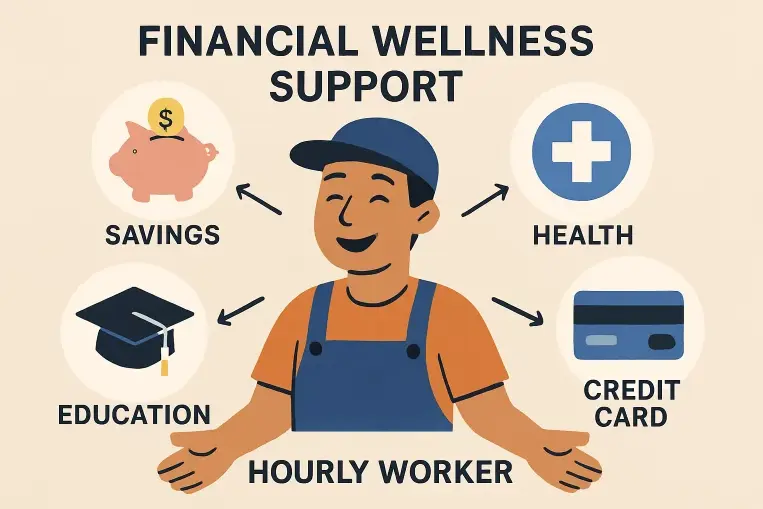Hourly workers form the backbone of countless sectors, fueling industries such as retail, hospitality, healthcare, and logistics. Yet, despite their pivotal roles, many of these employees struggle with persistent financial instability, often brought on by unpredictable schedules, fluctuating incomes, and limited access to comprehensive workplace benefits. In response to these challenges, employers and policymakers are increasingly focusing on innovative solutions to provide greater stability and support for this vital workforce. Among the most promising strategies are financial wellness programs, which go far beyond simple payroll adjustments by building a multi-faceted safety net. A crucial part of this approach, offered by leading earned wage access providers, is enabling workers to access their wages as they earn them, rather than being confined to the rigid timing of traditional payday cycles.
When employers incorporate earned wage access with health, education, and credit-building resources, they establish a comprehensive support system that helps hourly workers transition from merely making ends meet to achieving long-term financial stability. These holistic financial wellness programs often take inspiration from some of the top corporate wellness companies, which specialize in designing initiatives that blend physical, mental, and financial well-being. By integrating best practices from these leaders, organizations can create a healthier, more engaged workforce while reaping the benefits of improved productivity and employee retention.
Components of a Financial Wellness Program
Financial hardship among hourly workers is rarely limited to low wages alone—it often intersects with concerns around healthcare, credit access, and the ability to save for emergencies or future goals. A truly effective financial wellness program addresses all these dimensions to nurture both immediate security and long-lasting prosperity:
Health and Well-Being Services
Reliable healthcare access is a transformative benefit, especially for hourly workers who may not have traditional health insurance through their employers. Comprehensive wellness programs typically include offerings such as telemedicine solutions, which provide affordable and convenient virtual medical consultations, and mental health counseling services, which are vital for managing everyday stress and building coping skills. In addition, discounts on dental, vision, and even prescription medication can significantly ease financial burdens and help prevent medical emergencies that might otherwise lead to absenteeism or lost productivity. By prioritizing health and well-being as a foundation, employers can help create a secure environment, which in turn leads to enhanced job satisfaction, increased energy, and greater resilience.
Credit-Building Tools
For many hourly workers, low or nonexistent credit scores can be a significant barrier to achieving financial independence and accessing essential resources, such as affordable loans, reliable transportation, or new housing. Financial wellness initiatives often partner with credit bureaus and fintech providers to offer credit-builder loans, secured credit cards, and reporting services that reward timely payments. Programs may also offer personalized credit counseling or financial checkups, empowering employees to take actionable steps toward repairing and improving their credit profiles. Over time, these strategies not only lower costs through improved creditworthiness but also open pathways to vital financial milestones, such as homeownership or entrepreneurship, that might have previously seemed out of reach.
Financial Education
True empowerment starts with practical knowledge. The most impactful financial wellness programs offer ongoing access to a range of educational resources, including in-person workshops, online webinars, and interactive modules. These resources are designed to cover the fundamentals of budgeting, savings, debt management, and smart banking, emphasizing clear and actionable guidance for real-world situations. Some organizations even provide one-on-one coaching to help employees develop personalized plans for managing their daily finances and preparing for the unexpected. With the right education, hourly workers are equipped not just to avoid financial pitfalls but to actively pursue opportunities for growth and long-term security.
High-Yield Savings Accounts
Many hourly workers face barriers to establishing even a modest safety net, leaving them vulnerable to emergencies and high-cost borrowing. Financial wellness programs often remedy this by providing access to high-yield savings accounts that offer interest rates substantially above the national average, allowing every hard-earned dollar to grow faster. These accounts can be paired with automatic savings features, savings challenges, or employer-matched contributions to further incentivize participation and sustained savings habits. Over time, the ability to build an emergency fund or save toward important goals, such as education, housing, or retirement, redefines what is possible for workers who are often left out of traditional wealth-building opportunities.
Benefits of Earned Wage Access
One of the most significant developments for hourly workers in recent years has been the rise of earned wage access (EWA) solutions. According to U.S. News Money, EWA programs enable employees to access a portion of their already earned wages, either through a mobile app or direct transfer, offering unprecedented flexibility in managing day-to-day expenses. When emergencies arise or bills come due between paychecks, employees are no longer forced to rely on predatory payday loans, high-interest credit cards, or expensive overdraft fees.
This newfound flexibility supports responsible financial decision-making—workers can cover sudden expenses without accruing costly late fees or harming their credit ratings. From an employer’s perspective, partnering with trusted earned wage access providers supports workers’ overall well-being and sends a strong message that the organization cares about its employees’ financial security. The result is an atmosphere of trust and engagement, with measurable improvements in attendance, focus, and job satisfaction.
Impact on Employee Retention and Recruitment
Financial wellness initiatives serve as a crucial support system for employees, but their impact reaches employers just as deeply. Companies that implement comprehensive financial wellness programs often enjoy improved employee retention and attract more qualified candidates, strengthening both workplace culture and overall competitiveness in the job market. As explored in HR Dive, innovations like earned wage access exemplify how such benefits align with the evolving future of work.
This success stems from the trust, appreciation, and stability these benefits foster. When employees feel that their organization is genuinely committed to their long-term well-being, their engagement and motivation rise, encouraging them to perform at their best. In a competitive hiring environment, this leads to lower recruitment costs, more unified teams, and an enhanced organizational reputation, ultimately benefiting both employees and employers alike.
Implementing a Financial Wellness Program
To unlock the full potential of a financial wellness initiative, businesses and organizations should follow a deliberate, strategic process tailored to their unique workforce dynamics:
- Assess Employee Needs: No two workplaces are identical, and a successful program begins with a clear understanding of employees’ specific challenges. Conduct surveys or focus groups to identify pain points—whether it’s gaps in healthcare, budgeting troubles, or lack of access to credit.
- Select Appropriate Resources: Use the insights gained to choose resources that reflect your workers’ everyday realities. This might include identifying best-in-class earned wage access providers, partnering with respected financial education services, or integrating innovative credit-building tools.
- Communicate Effectively: Even the most thoughtfully designed benefits fall flat if employees remain unaware or unsure of how to access them. Highlight new resources through onboarding, staff meetings, digital updates, and regular workshops, and establish feedback loops to promptly address questions and resolve concerns.
- Monitor and Evaluate: Utilize data, feedback, and participation rates to track the impact of your financial wellness program, making adjustments as needed to ensure continuous improvement. Regular analysis ensures that benefits remain relevant and responsive, aligning with evolving employee needs and market trends.
In an increasingly competitive employment landscape, empowering hourly workers through financial wellness programs has shifted from a “nice-to-have” perk to a strategic cornerstone. By investing in initiatives that prioritize health, education, savings, and wage flexibility, companies can foster greater stability, engagement, and loyalty among their employees. As more employers recognize the direct link between worker well-being and organizational performance, financial wellness is becoming not just a benefit, but a catalyst for a happier, healthier, and more productive workplace.
Also Read-Pedrovazpaulo Wealth Investment: Your Path to Secure Financial Growth










